Emma Kwasnica, childbirth educator and breastfeeding advocate, logged onto Facebook new year’s day, 2009 to find her account had been deleted.
Why? Because Facebook “does not allow photos that attack an individual or group, or that contain nudity, drug use, violence, or other violations of the Terms of Use.
What was the photo? It was Emma breastfeeding her two children a mere six hours after the birth of her second. Now look at all the other photos shown in this essay. They too have been banned by Facebook.
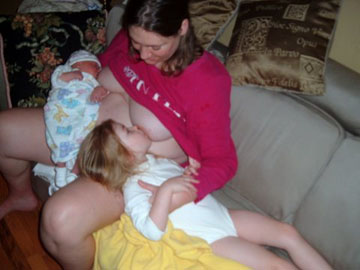
Photo by Emma Kwasnica
Each represents an incredibly private moment between mother and child, yes. But do they represent content that is“hateful, threatening, pornographic, or that contains nudity or graphic or gratuitous violence.”
Facebook says yes.
A Brief History of the Debate
Kelli Roman founded the Facebook fan group Hey Facebook, Breastfeeding Is Not Obscene after a photo of hers was deleted from her profile. Soon after, the group’s supporters hosted an online nurse-in to protest. Heather Farley, whose photo can also be found in this essay, organized the physical nurse in at Facebook, Inc. headquarters in Palo Alto, California.
Now it looks that there may be a class action lawsuit against Facebook. Those potentially leading the suit charge that while Facebook allows plenty of breast photos, it seems that breastfeeding ones have been specifically targeted for removal.
Hmmm, maybe that’s be the reason Facebook failed to return my repeated calls?
What Does Facebook Have To Say?
After the online and physical nurse-ins at Facebook headquarters, Facebook representative Barry Schnitt spoke to the press.
We agree that breastfeeding is natural and beautiful and we’re very glad to know that it is so important to some mothers to share this experience with others on Facebook. We take no action on the vast majority of breastfeeding photos because they follow the site’s Terms of Use. Photos containing a fully exposed breast (as defined by showing the nipple or areola) do violate those Terms and may be removed. These policies are designed to ensure Facebook remains a safe, secure and trusted environment for all users, including the many children (over the age of 13) who use the site.
Of course, Facebook does not address why the female nipple is objectionable yet the male nipple is not. Nor does Facebook explain why classic art imagery of Mary breastfeeding baby Jesus would be removed. Nor do we know why photos of mothers breastfeeding older children that show no exposed nipple or areola would present a danger to children.
Meanwhile, many legitimate groups and individual profiles display full and partial nudesand exposed breasts presented in a sexual or other non-breastfeeding related manner, yet those photos do not seem to be banned with equal frequency as breastfeeding photos.
What Is Their Policy?
It’s important to remember that Facebook itself does not choose photos for removal. Instead, they rely on community members to report photos they deem to fall outside of Terms of Service guidelines. The photos then go to a team of people within Facebook who make the final determination.
Dr. Paul Rapoport — the founder of Topfree Equal Rights Association an Ontario based group that advocates equal rights for women to go topless — believes Facebook’s policy to be random and impossible to enforce in any fair manner.
How they choose what they choose is an unanswerable question. They hire a bunch of people who don’t seem to have training. You can see from the photos that have been deleted there’s not much of a pattern to it. It’s sloppy and careless. With that kind of capricious nonsense, you can’t form any kind of rule.
In response to the Facebook bans, Paul published an entire section on his website of banned breastfeeding photos.
What Do Facebook Users Have to Say?
April Purinton posted this photo of herself tandem feeding her twins Rhys and Quin.
There is nothing in this photo that directly violates the guidelines Facebook determines. Yet her photo was removed with only an e-mail to let her know. She wasn’t even told which photo was removed, although it wasn’t difficult to ascertain.
“After three years of infertility and a traumatic and pre-term birth, I finally tandem nursed my babies successfully for the first time. Facebook told me this picture was offensive. And warned me that they will delete my account if I continue to break the rules.”
That same blog post includes examples of non-breastfeeding photos April found on Facebook that show the same amount of exposed breast, yet hers was singled out for removal.
The Cultural Aspects of Breastfeeding
Comments on a recent article on The Traveler’s Notebook highlight how different cultures and religions may inherently find an exposed breast to be offensive. Matador intern Heather Carreiro says she would feel uncomfortable sharing this photo with many of the people she knows from her time living and teaching in Pakistan.
It’s basically about the cultural relativism of modesty. In context of Pakistan and northern India, women — outside of posh areas — are expected to be covered. Leaving your dupatta (large scarf) at home or not using it fully cover your chest – in addition to your clothing – is seen as being close to naked. Even just seeing the contours of a woman’s body often makes people uncomfortable. With that in mind, you might be able to imagine how my sharing a link [with an exposed breast] would be kind of like sending a link to an X-rated site
007 Breastfeeding publishes a collection of person-on-the-street comments, asking people worldwide for their views on breastfeeding in public.
Breast feeding is very common in Pakistan. Even working women take babies to their working places and feed them. It is free source of pure milk, full of vitamins and protein. According to Islamic teaching, there is emphasis on mothers to adopt breast feeding for their babies up to two year duration.
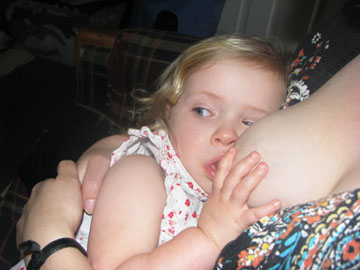
Photo by Heather Farley
Coincidentally or not, theWorld Health Organizationalso suggests two-years as the optimal time for mothers to breastfeed their children.
In fact, many countries, often considered as part of the imprecisely-titled undeveloped world consider breastfeeding to be the primary form of feeding infants and young children. In Ghana, where bottle feeding is for orphans, “if a baby cries and you do not breastfeed, people draw the conclusion the baby is not yours.”
But What About the So-Called Developed World?
In the United States, Canada and Europe, we regularly see partially nude women on television, movies and in advertisements. Even children’s movies include characters who expose almost as much breast as April Purinton or Emma Kwasnica do in their photos.
Why the disparity?
Why are western, non-religion based cultures so comfortable with breasts but not breastfeeding? What is it that causes so many western women to see two years of breastfeeding as an acceptable norm for women in these developing countries and yet not for themselves?
Economics certainly can play a large role in that. Let’s say you’re working a full time job. Are facilities available for you to breastfeed your child at work? Doubtful. It’s also likely your child will be at a daycare in another part of town and thus impossible for you to breastfeed.
If you still prefer your child receive breastmilk, you will then have to pump.
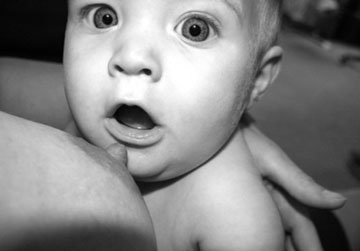
Photo by Anne Hinze
Which, if you’ve never pumped, as I assume a large percentage of the population has not, can be done by hand or with amachine.
Either way, it can be time consuming and often yield frustrating results as many women who could successfully breastfeed their children often will not find the same milk yield through the pump.
Economics, though, is most certainly not the entire story.
Says Iris Marion Young in The Politics of Women’s Bodies:
Patriarchal logic defines an exclusive border between motherhood and sexuality. The virgin or the whore, the pure or the impure, the nurturer or the seducer is either asexual mother or sexualized beauty, but one precludes the other. Breasts are a scandal because they shatter the border between motherhood and sexuality.
Have we become so conditioned as a society to see the female body as purely sexual that we have lost touch with reality?
Emma Kwasnica explains her point of view. “Breasts have the primary function of feeding babies.” While breasts do play a role in initiating the reproductive process, the reality is, they are one of many erogenous zones that come into play. There’s only one part of the body that produces milk enough to sustain a child for the first year of life.
Breasts are not biologically intended to solely play a sexual role in our lives, just as childbirth cannot exist independently of the sexual act. Yet somehow images of sexuality that include pregnancy, breastfeeding or other images of motherhood are considered perverse, obscene and pornographic.
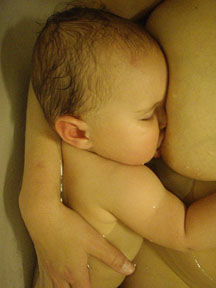
Photo by D. Miller
The community led banning of honest, normal photos of motherhood and the human body hints at a much larger issue.
It shows a slice of society that seeks to disassociate humans from their nature, ultimately turning women into large, empty breasted dolls designed for sexual pleasure and caricaturing men as primarily sexual beasts who have lost the capacity for multi-faceted thought in relation to the women with whom they attempt to mate.
In truth, divorcing form from function of the human body does us all a huge disservice. Are you suddenly no longer beautiful and sexual because you have become pregnant? What happens after labor and delivery? Will a man no longer be attracted to his female partner because he’s watched her give birth or breastfeed? Surely we are far more complicated and less capricious beings than that?
Barry Schnitt claims Facebook believes breastfeeding to be natural, beautiful and healthy. Based on the photos you see here and the guidelines presented by Facebook, does his statement ring true in your ears?
Breastfeeding and childbirth tie in closely to discussions of self-esteem and body image. How does the leaning to say only certain types of bodies or body parts are appropriate for public exposure while other types must hidden play itself out both as a cultural phenomenon and on the ways we see ourselves?
~/~
Story of a New York cabby:
http://www.nytimes.com/packages/html/nyregion/1-in-8-million/index.html#/andrew_baum
Breastfeeding and childbirth tie in closely to discussions of self-esteem and body image. How does the leaning to say only certain types of bodies or body parts are appropriate for public exposure while other types must hidden play itself out both as a cultural phenomenon and on the ways we see ourselves?
~/~
Story of a New York cabby:
http://www.nytimes.com/packages/html/nyregion/1-in-8-million/index.html#/andrew_baum

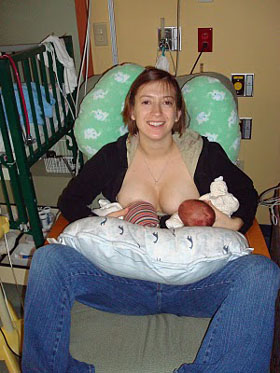
No comments:
Post a Comment
Cool comments.